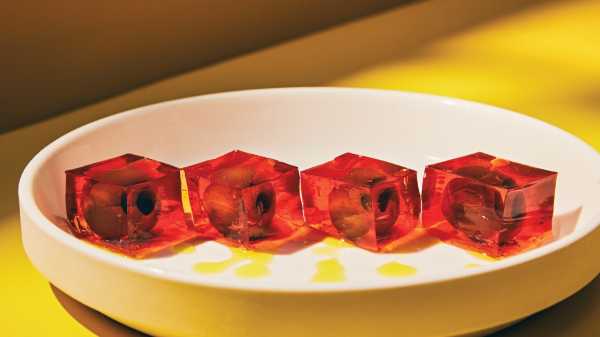
Save this storySave this storySave this storySave this storyYou’re reading the Food Scene newsletter, Helen Rosner’s guide to what, where, and how to eat. Sign up to receive it in your in-box.
Humor might be the hardest thing in the world for a restaurant to get away with. Plenty of attempts can be found in the city’s dining rooms, especially at the billionaire-bait tasting-menu spots, where caviar presented in an ice-cream cone is hailed as the pinnacle of whimsy, and at restaurants embracing the new school of self-aware, proudly stupid maximalism—places like Bad Roman, the impossibly popular restaurant in Columbus Circle, where shots of booze roll across your table affixed to toy cars, the room is a series of Instagram opportunities, and the food is an opulent afterthought. Café Mars, a new restaurant in Brooklyn’s Gowanus neighborhood, bills itself as “an unusual Italian restaurant,” and I was worried, heading in, that I would find myself feeling coerced into surprise or amusement as each dish hit the table. I don’t know what I was so afraid of. “Unusual,” in Café Mars’s case, thank goodness, doesn’t mean predictable trompe-l’oeil, or edgy for the sake of edgy. The flavors on the menu are familiarly Italianate (and Italianate Americana), but they come in unexpected combinations, in weird and wondrous shapes and textures.
The restaurant, open since May, sits on a stretch of Third Avenue in Brooklyn that has not yet been overtaken by the luxury high-rises colonizing the area around the Gowanus Canal like a glass-walled algal bloom. Before its recent makeover, the space was home to an Italian deli; decades before that, it was a pasta factory. During a recent meal there, Paul D’Avino, who with Jorge Olarte is the co-chef and co-owner, stopped by my table and pointed in the direction of the front door. “When my great-grandfather moved here from Campania, he lived right there, across the street,” he said. “We were going to turn this place into an izakaya, but I had to do right by my bisnonno.”
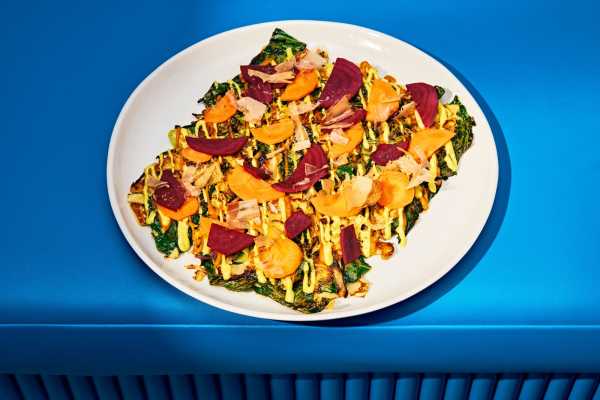
The menu’s “pancake primavera” is a big, trembling okonomiyaki of Italian greens and pickled root vegetables.
The dining room doesn’t feel much like the sort of Italian restaurant anchored in ancestral tradition. D’Avino and Olarte—alumni of such blue-chip kitchens as wd-50, Momofuku Ssäm Bar, and the Noma fermentation lab—bypassed the trattoria-rustica vibe in favor of something slicker, more modern, less fettered: smooth white walls, curvilinear shapes, and geometric hunks of color inspired by the Memphis Milano design movement. The booths in the front dining room are rain-slicker yellow; the custom-designed chairs at the bar have wiggly fluorescent-pink legs; the wavy tables in the back dining room are custom-shaped to fit together like puzzle pieces for larger parties. The open kitchen is separated from the dining room by an emerald noren curtain, one of many signs of the restaurant’s original interest in Japanese cuisine. Colorful neon lights outline cutouts where the original brick walls show through, the rough-hewn past peeking into the sleek, playful now. Everyone looks gorgeous in this dining room, cross-lit by multicolor lights; a woman a few tables away from me, waiting for her friend, dressed all in white and reading the new Emma Cline (apple-green cover, royal-blue text) could have been placed by a set designer.
Debbie Harry rocks the dining room, while the bathroom soundtrack is an endless playlist of the late comedian Mitch Hedberg, deadpan and absurd: “I had a piece of Carefree sugarless gum, and I was still worried. It never kicked in.” There are actual jokes on the menu, too, if you know what you’re looking for: pearlescent cubes of sea-bass crudo bathed in a pool of “crazy water,” or acqua pazza, a tomato-based Neapolitan poaching broth that here is served cold, arrive under a snowdrift of—gasp—grated Parmesan, a willfully heretical rejection of the Italian rule never to pair cheese with seafood. But what makes the combination work as wit is that it also works as art: even if you don’t realize you’re biting a thumb at tradition, you know you’re eating something sly and elegant and expertly composed, the intense umami of the Parmigiano bringing a miso-like roundness and intensity. The cheese doesn’t just make the punch line; it makes the dish.
A meal at Café Mars begins with a splash of ceremony: a server shimmers to the table bearing a woven basket full of mismatched stemware, and two bottles (something sparkling, something nonalcoholic—when I visited, a vivacious prosecco and a sweet rosé cider) from which to pour a preprandial sip. From there, it seems, almost every table orders a plate of quivering dark-orange gelatin cubes. These are “jell-olives”: gently saline Castelvetrano olives suspended in cubes of Negroni jello, like specimens in a murky jar. They are—this is an unreserved compliment—completely horrifying, an exercise in absurdism. The flavor is fantastic, bright and briny, but the firm flesh of the olive and the blobbily collapsing gelatin combine in the mouth to create a visceral texture that I loathed bodily and also immediately wanted to experience again.
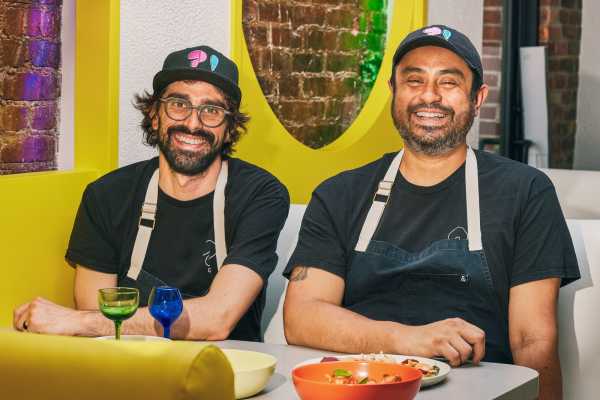
Paul D’Avino and Jorge Olarte are the co-owners and co-chefs of Café Mars.
The rest of the menu, blessedly, offers more straightforward pleasures. During the course of two visits, I tried nearly every dish from the tightly edited selection: four snacks, five small plates, four pastas, and three large-format entrées. Skip the garlic-knot monkey bread—not bad, but dry, and the loaf is oversized for any party smaller than six—and start instead with a tiny bowl of anchovies, dark and moody, curled up in an aromatic bath involving “pizza crust oil” (made by literally blending house-made pies with olive oil), topped with slivered peperoncini, and served alongside a wedge of milky-white focaccia. Order that blasphemous crudo along with the punchy salad of sweet seasonal cucumbers, trout roe, and delicate flakes of whey granita, dressed in a bracingly green-tasting tarragon oil. D’Avino’s cheeky composition of shaved celery, hunks of charred octopus, and tiny circles of crispy pepperoni—doused in ranch dressing—is the rare dish that wouldn’t feel out of place in a high-end Portuguese beach town, at a Midwestern potluck, or on the menu at Prune, circa 2010. It was so good I ordered it twice.
The handle on the door to Café Mars is a fettuccine-extrusion die; D’Avino and Olarte clearly take the matter of pasta very seriously. They make their own, and seem to relish reviving obscure or underappreciated forms. Girelle—a sort of fat, curly-edged double helix—are served with “lemon, lemon, lemon” (butter, zest, bread crumbs) and capers and basil in a meatless evocation of piccata. The shape that the menu simply calls “waves”—scalloped curls that crest like Kanagawa’s great billow—is the best thing on the entire menu. The waves are served in a heap with fresh peas and a handful of enormous shrimp, tossed in an orangey-red sauce that might pass, in a photo, as something predictable and tomato-based, but the nose and mouth (and eyes, watering) know better: it’s pure Calabrian chili, with a spiky, brittle heat just barely tempered by butter—a pasta dressed in the world’s fanciest Buffalo sauce.
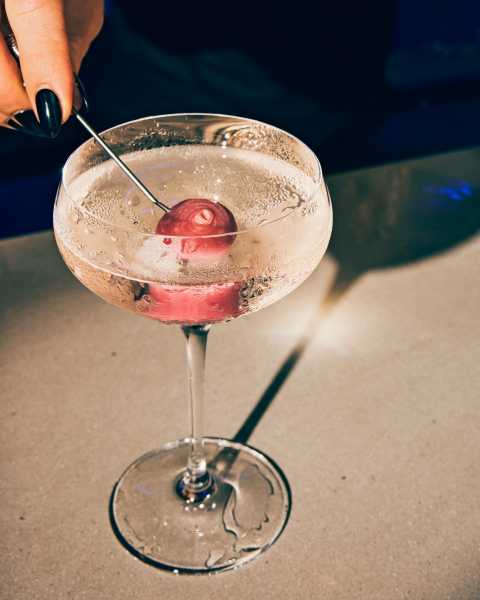
The restaurant’s Gibson Martini was developed by the general manager Madalyn Summers.
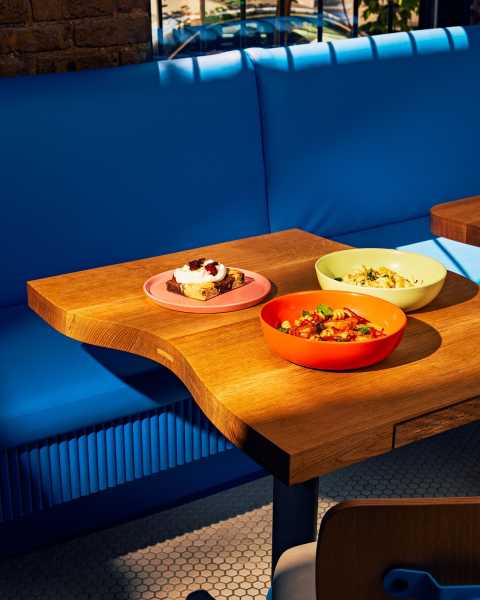
The Memphis Milano design movement served as inspiration for the dining room’s curvilinear shapes and geometric hunks of color.
The menu, which D’Avino and Olarte plan to change with the seasons, is for now overwhelmingly light: dishes are bright, produce-forward, and mostly sized for grazing rather than for gut-busting. My favorite of the larger plates was the “pancake primavera,” a big, trembling okonomiyaki of Italian greens and pickled root vegetables. Held together with just a whisper of binder, it was as weightless as the bonito flakes that danced atop it. The menu’s confident creativity extends to the desserts, most notably in a slice of crumbly olive-oil cake whose dark marble swirl is made up not of chocolate but of puréed black olive. Under a dollop of whipped cream and blood-red marinated cherries, it was salty, undeniably weird, and absolutely correct. A more traditional dish of fresh strawberries in a zabaglione was light as sea-foam. In the thick heat of summer, I couldn’t imagine anything better—especially because the restaurant’s air-conditioning was on the fritz when I visited, though their Gibson Martini, developed by the restaurant’s general manager, Madalyn Summers, was icy cold.
The menu does hold hints of heartier things to come: a note-perfect braised-beef-and-onion ragù dresses a cord of rigidly geometric trenne—triangular penne, a jolting departure from the tubular pasta’s expected sensuous roundness. Parmigiana, that old red-sauce standby, gets a Flintstonian makeover with the use of rich, smoke-kissed pork ribs—a slab of four, on the bone, breaded and fried and smothered in the requisite marinara and cheese, and presented with a knife stuck in its middle. It’s accompanied by a tangle of Japanese spaghetti salad, itself an adaptation of American-style macaroni salad, mayo dressing and all, that in Japan would be made with cubes of ham but here nods to Italy with the substitution of fried mortadella. It’s devilishly clever—a riff, a callback, the rare side dish that rewards close reading. But nothing ruins a joke quite like having to explain it. More important than being devilishly clever, it was devilishly good. ♦
Sourse: newyorker.com






